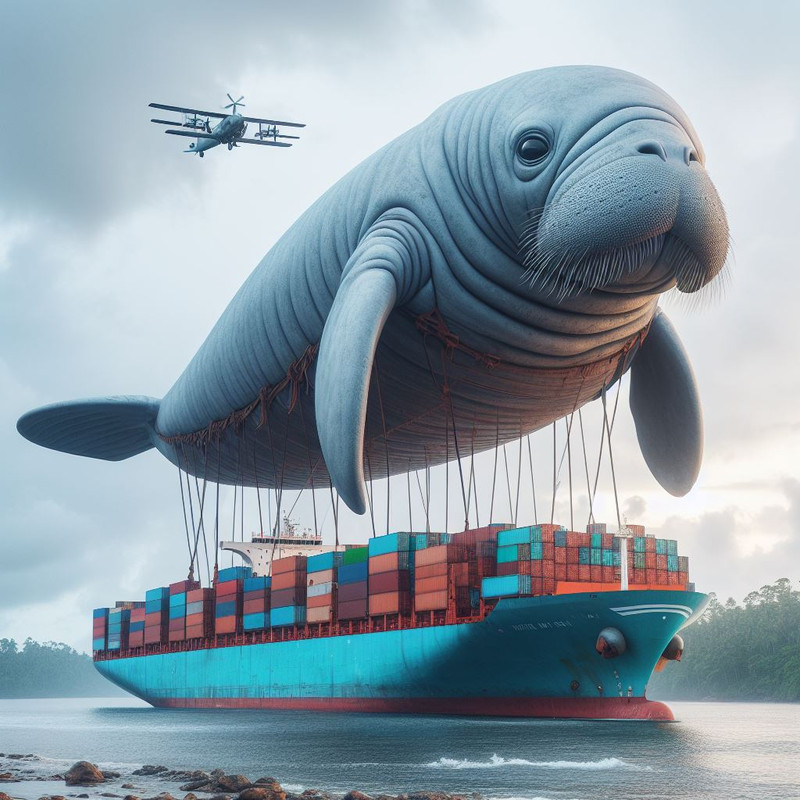I understand that. I just think it is a ridiculously low cap.
They should just attach a whole bunch of helicopters and fly them out.
Blimps! We need ship-lifting blimps. That’s the answer!
Maybe Musk can build design sketch propose a big-ass submarine to load them up and take them out.
I laughed out loud. For real. Nicely done!
Created by DALL-E I hope.
Bring in the Flying Whales!
This project gives me so much joy, I actually want to see it succeed!
Hey, it worked for the Titanic…
For reference’s sake, here’s the specific bit of the US Code that creates that limitation of liability:
Much of the rest of the world implements the Convention on Limitation of Liability for Maritime Claims (LLMC). The USA (always exceptionalist) is not a party to the LLMC but has a similar scheme loosely based on LLMC or its forerunners. The limits under the LLMC have been updated from time to time. If this casualty had occurred in a jurisdiction that implements LLMC with the latest limits, the limits would have been (depending on exchange rates) approximately :
Claims for loss of life or personal injury – USD116M
Other claims - USD58M
The LLMC limit is regarded as virtually unbreakable – that is, while the limit theoretically can be broken under certain circumstances of extreme culpability, as a matter of practicality those circumstances will essentially never arise. I know little about US limitation law but as I read the statute the US limit is probably rather more easily broken particularly with the prevalence of jury trials in the USA. I could be wrong about that though.
Ship liability insurers are fully familiar with limitation of liability for maritime claims, and consequently it is always invoked when available.
However, incidents don’t hit limitation very often at all, and someone can easily get through an entire career working in ship-owning and operations without being involved in a single incident that reaches limitation, and consequently IME shipowners usually aren’t aware of it. I have had only a handful of limitation cases in my 30+ year career and in the three where I can recall, the shipowner wasn’t aware of limitation till I told them.
Alternatively I strongly suggest that you don’t watch this 25 minute video since based on the small amount I could stand to sit through, you will only increase your level of ignorance. Because he only half knows what he’s talking about, it’s full of half truths which are the worst sort.
I suspect what you are talking about in your second paragraph is General Average which concerns additional costs of a voyage due to circumstances outside a shipowner’s control – not liability but costs.
I’m not sure what your second para is based on but I suspect (if it’s correct at all) it is based on some half-understood principle of US maritime law - perhaps limitation since as I’m reading it if the ship and all cargo is lost limitation may be zero.
Sorry my last para should read:
Am much relieved at hearing your assessment.
I was beginning to think I’d been working in some parallel universe of import/export trading for the past 35 years.
As to question of the ownership goods, freight charges and risk, the graphic below of standard INCOTERMs demonstrates the permutations.
The obligations of risk/insurance of traded goods while in transit is a contracted agreement between buyer and seller. There is no involvement with the shipping line, except in meeting accreditation as a suitable carrier with the buyer or sellers maritime insurer.
This is largely irrelevant to the current topic. INCOTERMS concern who pays for freight and insurance, and the passing of title and risk, as between buyer and seller (known collectively in the trade as “cargo interests”). INCOTERMS are relevant only as between them.
INCOTERMS have no substantive relevance to the liability (if any) of carriers to cargo interests. Such liability is a completely separate topic governed by the terms of the contract of carriage and/or various statutes and international treaties.
Almost invariably, when cargo is lost or damaged, cargo interests are paid out by cargo underwriters. Cargo underwriters then consider whether they have a viable right of recovery against the carrier/s. If so, they pursue that recovery claim under subrogated rights. Very often this recovery is completed without any or any significant involvement of cargo interests themselves.
Which is probably why you have had nothing to do with it.
Former Director Port of Baltimore discusses the ongoing recovery.
He handled the recovery of a grounded Container Ship in the port a couple years ago.
Baltimore has a lot of cranes, steel recycling, and experience to expedite this recovery.
Have they started lifting any of the bridge out yet?
This local news clip visited the wreck and reported one 200 ton piece had been cut and put on a barge. It took ten hours to lift it from the water.
The cleanup will be a long process and could provide employment for hundreds of workers.
They said it’s been windy so maybe that slowed things down. It’d still like to see the process in action. It looks incredibly dangerous to cut through beams that could shift when separated. I was expecting the workers to be farther away from the actually cutting process.
This is the work of a year, with a winter off. Holding work for a couple days for adverse weather is smart.
Robotic tools are farther in the future than we might wish.
Meantime these poor bastards need a job. And probably a rather high-paying one.
They’d much rather their robotic replacement take its time arriving.
Third body recovered late yesterday


